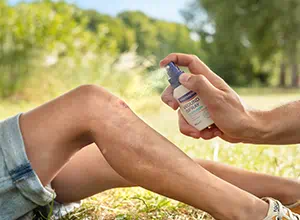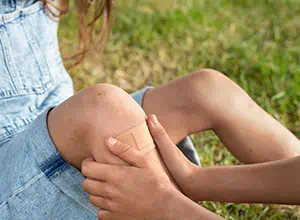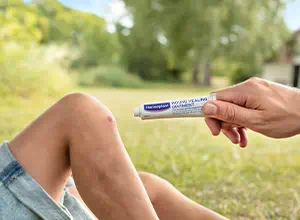Hansaplast Sensitif plasters are extra skin friendly and are suitable for covering all types of smaller wounds.
The comfortable material is hypoallergenic and breathable. The non-stick woundpad protects and cushions the wound. The secure and skin friendly adhesion ensures that the plaster stays in place but is still painless to remove.

Features:
-
For larger and post-operative wounds
-
Sterile
-
Waterproof film ideal for washing, showering, bathing and swimming
-
Highly absorbent, non-stick wound pad
-
Protects from infection
How To Use:
 |
1. Cleanse Cleansing the wound from dirt and bacteria is an essential first step to enable optimal healing. To prevent wound infections, spray the Hansaplast Wound Spray from a distance of approximately 10 cm onto the entire wound area. Repeat if necessary, then gently dry the wound and surrounding skin area.
|
 |
2. Protect Next, it’s important to protect the wound from external influences like dirt and bacteria to enable undisturbed healing. Cover your wound with the Hansaplast sterile wound dressing that best suits your needs. Observe your wound and change the plaster or dressing daily unless you’ve been recommended to do otherwise by your doctor. Apply the Hansaplast sterile plaster without stretching and wrinkling. Press the plaster on firmly. See also illustrations below.
In case of post-operative wounds follow your doctor’s recommendations. |
 |
3. Heal Help your wound heal safely, quickly and with a lower risk of scarring. Apply Hansaplast Wound Healing Ointment regularly until your wound has healed completely. Carefully apply a thin film one to two times per day. Make sure the opening of the tube does not get in contact with your wound. Repeat regularly until the healing is completed. The Hansaplast Wound Healing Ointment can be used on open minor superficial wounds and at any stage of the healing process. If necessary, cover the wound with a plaster, dressing or compress. If your wound is post-operative, please consider that step optionally and only when your wound is closed. |
Packaging Size:
Size: 19 X 72mm 14 Strips
30 X 72 Strips
Q&A
1. How often should I change my plaster?
Usually, it is recommended to change Standard First Aid Dressings daily due to hygienic reasons.
2. Is it better to let small wounds dry at the fresh air instead of putting on a plaster?
It is one of the wound care myths that keeping minor cuts and grazes uncovered and letting them exposed to the air helps them to heal faster. The contrary is true! Research shows that covered wounds heal more efficiently and have a reduced risk of infection. Hansaplast products provide protection until the wound is completely healed.
3. When should I consult a doctor?
We recommend contacting a medical professional under the following circumstances:
- if the wound is deep and causing major bleeding
- if the wound shows signs of infection such as redness,
warmth, pain and swelling - if there are embedded foreign objects in it
- in case of animal or human bites
- if the wound is in the area of the face
- if there is insufficient tetanus vaccination
and of course always when you have questions or are uncertain.
4. When if my wound gets infected and sappurates?
You should contact a medical professional if you recognize signs of infection. This is not only the occurrence of pus but also swelling, redness, heat, pain, itching or burning. In case of infection the wound will need medical care and special medical treatment.
5. Which plaster should I use for larger wounds with my sensitive skin?
If you have sensitive skin, we recommend using the Hansaplast Sensitive XL/XXL, which is extra skin friendly and also suitable for post-operative wounds.
6. Which Hansaplast plasters are waterproof and water-resistant?
The Hansaplast Aqua Protect and Aqua Protect Sterile XL/XXL strips are waterproof and will not go off while washing or showering. The Hansaplast Elastic range is water-repellent. The material keeps water on the surface where it beads off. All Hansaplast Universal plasters as well as the Kids plasters are water-resistant.

















